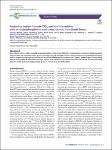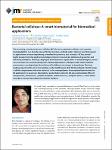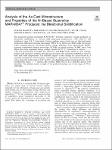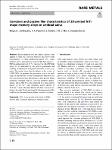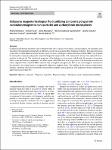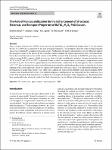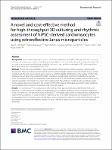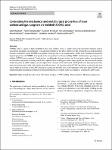Search
Author
- Osman, Ahmed I. (5)
- Daqing, Ma (3)
- Jorgensen, Ed (3)
- Li, Yan (3)
- next >
Subject
- kinh tế (26)
- Economics (12)
- programming (10)
- XRD (10)
- next >
Date issued
- 2020 - 2025 (2129)
- 2010 - 2019 (129)
- 2000 - 2009 (9)
- 1999 - 1999 (1)
Has File(s)
Search Results
Barium titanate (BTO) is a widely researched ferroelectric useful for energy storage. While BTO’s surface chemistry is commonly studied using density functional theory, little has been published on the TiO2 surface. Here, we determined that BTO’s surface response can be decoupled from the ferroelectric response by using a pre-optimized ferroelectric slab and allowing only the top three atomic z-layers to respond to ligand binding. Multiple favorable binding modes were identified for hydrogen, hydroxyl, water, and tert-butyl phosphonic acid on BTO’s TiO2 surface. Of these ligands, tBuPA dominates surface binding with binding energies as low as − 2.61 eV for its nine configurations. |
The escalating curiosity in bacterial cellulose (BC) due to exceptional attributes such as purity, biodegradability, non-toxicity, porous fibrillar structure, and high water retention potential expand its applications to tissue engineering, controlled drug delivery, and cosmetics. BC has proved highly prospective to be used to manufacture innovative wound care solutions, drug carriers and delivering complexes. The drug-carrying BC found enormous applications in dental therapies, wound care, and scare-free wound management. Various degradation techniques of BC under antibiotic environments and physiological conditions offer different advantages in drug design. |
The presented research investigates MAR-M247® Ni-based superalloy castings produced via directional solidification at various mold preheating temperatures (1510, 1566 °C) and withdrawal rates (3.4, 5.0 mm/min). Casting analyses were carried out via thermodynamic simulations, differential scanning calorimetry (DSC), X-ray diffraction (XRD), light microscopy (LM), scanning electron microscopy (SEM), energy dispersive X-ray spectroscopy (EDX), scanning transmission electron microscopy (STEM), and tensile testing. On DSC curve, four effects have been registered during cooling: liquidus (1337 °C), formation of eutectic γ − γ′ (1315 °C), precipitation of Ni7(Hf, Zr)2 (1244 °C), and M5B3 borides (1201 °C). The castings’ primary and secondary dendrite arm spacing decreases with increasing w... |
Electrochemical tests and surface analysis were applied to study the corrosion behavior and passive film characteristics of three-dimensional-printed NiTi shape memory alloys fabricated by laser-powder bed fusion (L-PBF) in artificial saliva at 37 °C. The passivity of L-PBF NiTi shows to be influenced by the process parameters and resulting morphological and physicochemical surface properties. The results show that the defects at the surface of L-PBF NiTi can promote the passivation rate in the early stages of exposure but a slowly formed passive film shows the best corrosion protection. The thickness of the passive film is positively correlated with its corrosion protective performance. The L-PBF NiTi alloy prepared at a linear energy density of 0.2 J·m−1 and volumetric energy dens... |
The present study employs a multidisciplinary approach to highlight the risks of urban expansion on buried cultural heritage sites. The buried temple of Ramses II in Akhmim city was chosen as a case study to assess the impact of urban expansion on its preservation. Support Vector Machine (SVM) classification was utilized to analyze satellite images from multiple sensors and evaluate the extent of urban growth surrounding the temple. The study also incorporated petrographic and mineralogical analyses of statues discovered in the temple, along with calculations of saturation indices, to assess the potential interactions between groundwater and archaeological materials. The findings indicate that urban development is encroaching upon the temple, posing potential risks to its preservati... |
Conductive polypyrrole nanotubes were synthesized with a two-step one-pot synthesis. During synthesis, the nanotubes were decorated with magnetite nanoparticles at different concentrations granting them magnetic properties. The characterization of the tubes revealed differences from the theoretical reactions. A bidisperse magnetorheological fluid (MRF) was prepared by mixing the composite polypyrrole nanotubes/magnetite nanoparticles with commercial carbonyl iron spherical microparticles in silicone oil. The rheological properties of the bidisperse system were studied under the presence of magnetic field at room and elevated temperature. |
Glass-ceramic nanocrystals (GCNs) were created via annealing at crystallization temperature Tc for the parent BaTiO3-V2O5-PbO glasses prepared by the melt quenching technique. The amorphous character of the existing quenched glasses was confirmed by scanning electron microscopy. Furthermore, the general characteristics of x-ray diffraction support the amorphous nature of the glasses. In the related heat-treated samples, the typical nanostructure size is less than 60 nm. It was discovered that an increase in the density of the GCNs occurred with an increase in the BaTiO3 percentage. Also, with increasing BaTiO3 content, a slight increase was observed in the crystallization and glass transition temperature from 335°C to 365°C and 265°C to 320°C, respectively. |
Experimental fatigue tests with variable amplitude (VA) load were conducted for notched uncoated and hot-dip galvanized (HDG) notched laser cut components made of S960 ultra-high-strength steel (UHSS). Tests were conducted with low (constant minimum) and high (constant maximum) mean stresses and major differences between fatigue lives with the tests on identical equivalent stress were found. A multiparametric 4R method application, in conjunction with the theory of critical distances (TCD) to obtain fatigue-effective stresses at notch, was utilized on the mean stress correction and fatigue strength assessment. The introduced 4R method was proven to be highly efficient to consider different mean stress levels based on the experimental results and different loading and specimen types ... |
Human induced pluripotent stem cell-derived cardiomyocytes (hiPSC-CMs) gain attention as a potent cell source in regenerative medicine and drug discovery. With the necessity of the demands for experimental models to create a more physiologically relevant model of the heart in vitro we herein investigate a 3D culturing platform and a method for assessing rhythm in hiPSC-CMs. |
S500MC steel is a grade of high-strength low-alloy steel (HSLA) which is widely used in the automotive industry and for agricultural machinery and equipment. Considering properties of this alloy, selection of the welding process and parameters becomes essential to ensure that HSLA assemblies meet specific service requirements. In this work, mechanical and metallurgical properties of S500MC steel produced by autogenous laser beam welding (LBW) and automatic gas tungsten arc welding (GTAW) were compared. Tensile testing, metallography, hardness testing, and fractographic analysis were performed on the welded specimens, revealing that the heat input by these welding processes caused significant microstructural changes within the joints. In LBW samples, the heat input about 10 times low... |

